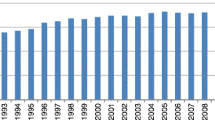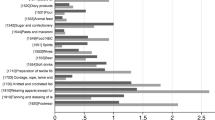Abstract
A large empirical literature suggests the performance characteristics of firms that export are different from firms that do not. Specifically, exporters tend to be larger, more productive and pay higher wages than non-exporters. This paper reports on an econometric analysis of the characteristics of exporters and non-exporters in Swedish manufacturing industry. We use matching and difference-in-differences analysis to investigate a panel data set on a large number of firms and spanning almost 20 years. Some of our results echo those reported elsewhere. However, in contrast to the findings for every other country analysed so far, we find that the performance characteristics of exporters and non-exporters are remarkably similar. In particular, we find no evidence of pre- or post-entry differences in firm level productivity. This is a striking outcome, probably driven by the extremely high openness of the Swedish economy.
Similar content being viewed by others
References
Alvarez, A., and R. Lopez (2004). Exporting and Firm Performance: Evidence from Chilean Plants. Mimeo. Indiana University, Bloomington, IN.
Aw, B. Y., and A. R. Hwang (1995). Productivity in the Export Market: A Firm Level Analysis. Journal of Development Economics 47 (2): 313–332.
Baldwin, J., and W. Gu (2004). Trade Liberalisation, Export Market Participation, Productivity Growth and Innovation. Oxford Review of Economic Policy 20 (3): 372–392.
Bernard, A., and J. B. Jensen (1999). Exceptional Exporters’ Performance: Cause, Effect or Both? Journal of International Economics 47 (1): 1–25.
Bernard, A., and J. Wagner (1997). Exports and Success in German Manufacturing. Review of World Economics/Weltwirtschaftliches Archiv 133 (1): 134–157.
Blalock, G., and P. Gertler (2004). Learning from Exporting Revisited in a Less Developed Setting. Journal of Development Economics 75 (2): 397–416.
Blundell, R., and M. Costa Dias (2000). Evaluation Methods for Non-Experimental Data. Fiscal Studies 21 (4): 427–468.
Castellani, D. (2002). Export Behaviour and Productivity Growth: Evidence from Italian Manufacturing Firms. Review of World Economics/Weltwirtschaftliches Archiv 138 (4): 605–628.
Clerides, S., S. Lach, and J. Tybout (1998). Is Learning by Exporting Important? Micro-Dynamic Evidence from Colombia, Mexico and Morocco. Quarterly Journal of Economics 113 (1): 903–948.
Damijan, J. (2006). Does FDI Substitute for Exports? Firm Level Evidence for Slovenia. World Economy 29 (forthcoming).
Delgado, M., J. Fariñas, and S. Ruano (2002). Firm Productivity and Export Markets: A Non-Parametric Approach. Journal of International Economics 57 (2): 397–422.
Girma, S., D. Greenaway, and R. Kneller (2003). Export Market Exit and Performance Dynamics. Economics Letters 80 (2): 181–187.
Girma, S., D. Greenaway, and R. Kneller (2004). Does Exporting Increase Productivity? A Microeconomic Analysis of Matched Firms. Review of International Economics 12 (5): 855–866.
Greenaway, D., and R. Kneller (2004). Exporting and Productivity in the United Kingdom. Oxford Review of Economic Policy 20 (3): 358–371.
Greenaway, D., and R. Kneller (2005). Firm Heterogeneity, Exporting and Foreign Direct Investment: A Survey. GEP Research Paper 2005/32. University of Nottingham.
Greenaway, D., and Z. Yu (2004). Firm Level Interactions between Exporting and Productivity. Review of World Economics/Weltwirtschaftliches Archiv 140 (3): 376–392.
Hansson, P., and N. Lundin (2004). Exports as an Indicator on or Promoter of Successful Swedish Manufacturing Firms in the 1990s. Review of World Economics/Weltwirtschaftliches Archiv 140 (3): 415–445.
Helpman, E., M. Melitz, and S. Yeaple (2004). Export versus FDI. American Economic Review 94 (1): 300–316.
Hopenhayn, H. A. (1992). Exit, Selection, and the Value of Firms. Journal of Economic Dynamics and Control 16 (6): 621–653.
Jean, S. (2002). International Trade and Firms’ Heterogeneity under Monopolistic Competition. Open Economics Review 13 (3): 291–311.
Kraay, A. (1999). Exports and Economic Performance: Evidence from a Panel of Chinese Enterprises. Revue d’Economie du Dévelopment 7 (1/2): 183–207.
Kneller, R., and M. Pisu (2006). Export Spillovers from FDI. World Economy 29 (forthcoming).
Levinsohn, J., and A. Petrin (2003). Estimating Production Functions Using Inputs to Control for Unobservables. Review of Economic Studies 70 (2): 317–341.
Medin, H. (2003). Firms’ Export Decisions-Fixed Costs and the Size of the Export Market. Journal of International Economics 61 (1): 225–241.
Melitz, M. (2003). The Impact of Trade on Intra-Industry Reallocations and Aggregate Industry Productivity. Econometrica 71 (3): 1695–1725.
Olley, S., and A. Pakes (1996). The Dynamics of Productivity in the Telecommunications Equipment Industry. Econometrica 64 (4): 1263–1298.
Rosenbaum, P., and D. B. Rubin (1983). The Central Role of the Propensity Score in Observational Studies for Causal Effects. Biometrika 70 (1): 41–55.
Sianesi, B. (2001). Implementing Propensity Score Matching Estimators with Stata. Available at http://fmwww.bc.edu/RePEc/usug2001/psmatch.pdf.
Van Biesebroeck, J. (2003). Exporting Raises Productivity in Sub-Saharan African Manufacturing Plants. NBER Working Paper 20020. National Bureau of Economic Research, Cambridge, Mass.
Wagner, J. (2002). The Causal Effects of Exports on Firm Size and Productivity: First Evidence From a Matching Approach. Economics Letters 77 (2): 287–292.
Wagner, J. (2004). On the Microstructure of the German Export Boom: Evidence from Establishment Panel Data, 1995–2002. Review of World Economics/Weltwirtschaftliches Archiv 140 (3): 496–509.
Wagner, J. (2006). Exports and Productivity: A Survey of Evidence from Firm Level Data. World Economy 29 (forthcoming).
Author information
Authors and Affiliations
Corresponding author
Additional information
JEL no.
F14
About this article
Cite this article
Greenaway, D., Gullstrand, J. & Kneller, R. Exporting May Not Always Boost Firm Productivity. Rev. World Econ. 141, 561–582 (2005). https://doi.org/10.1007/s10290-005-0045-5
Issue Date:
DOI: https://doi.org/10.1007/s10290-005-0045-5




